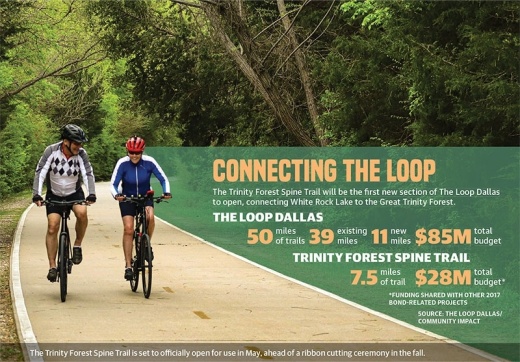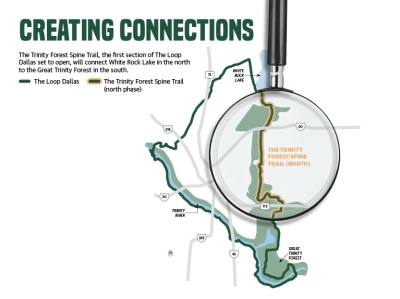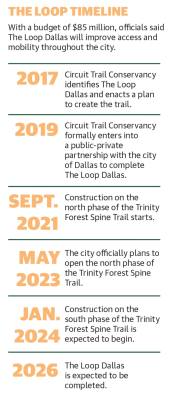The new trail is part of a project called The Loop Dallas that will connect many of the city’s trails into a contiguous 50-mile urban trail. Overall, the $85 million project will link 39 miles of the city’s existing trails with 11 miles of four newly built trails, including the Trinity Forest Spine Trail.
The new trail is being constructed in two phases: the north phase, which is 4 miles long, and the south phase, which is 3.5 miles long. The north phase, which is partially opening in May, will connect the Santa Fe Trail at White Rock Lake to the Trinity Forest trail system, said Philip Hiatt Haigh, executive director of The Loop Dallas, the city’s nonprofit partner in creating the trail that was formed out of public-private partnership The Circuit Trail Conservancy.
The north phase is being constructed and opened in two separate 2-mile phases. Hiatt Haigh said the first section completing construction cost $8 million, while the other shares $20 million in funding from the 2017 bond program with another upcoming trail. In addition, the project is being funded with private money and funds from the Texas Department of Transportation.
Hiatt Haigh said the new trail will provide essential connectivity to residents living alongside it.
“The Trinity Forest Spine Trail ... is going to be the first dedicated connection that says, ‘You don’t need a car to get outside of your neighborhood, you’re connected to the rest of Dallas with this amenity,’” Hiatt Haigh said. “We haven’t had anything like that in our city before.”
The new section plays into the idea behind The Loop Dallas, which is to “connect Dallas to Dallas,” Hiatt Haigh said. By connecting every section of Dallas through a continuous trail, The Loop is intended to revitalize communities and connect residents to amenities like lakes, restaurants, forests, farms and more around the city.
Connecting cyclists
Jessica Scott, bicycle and micromobility manager for the city of Dallas, said officials have used the Dallas Bike Plan to implement bike lanes throughout the city to make its trails more accessible to cyclists. The plan lays out future bicycle and roadway improvements needed in Dallas, with one of the city’s goals to create a seamless off-street and on-street network of bike lanes and trails.
“The [existing] trails are great, but a lot of folks are stuck with no other option than to drive to the trails to be able to bike,” Scott said. “We want to extend the opportunity to [residents] through on-street bike lanes so they can access the trails throughout the city.”
With the new sections of The Loop Dallas, the city is working to connect its on-street bike lanes to the trail crossings near Dallas Area Rapid Transit stations. For the Trinity Forest Spine Trail, the city plans to implement on-street bike lane access to the trail near Samuell-Grand Park and the Tenison Park Golf Course, although a timeline for completion of those lanes has not been set, Scott said.
Ward Rushton, a cyclist who lives in the Lakewood-Lower Greenville area, said he often uses DART to get to the trails he rides on, and he finds it easy to access most trails from a nearby station.
“All of the trailheads that are near DART stations are great because it’s really easy to load up a bunch of bikes with you and your friends, and then go out to a trailhead,” Rushton said.
Increasing safer mobility
Having these on-street bike lanes connect to The Loop Dallas will not only improve mobility and accessibility for cyclists, but they will also make roadways safer for everyone, Scott said. With the increased micromobility accessibility, she said residents can take advantage of Dallas’ trails for both recreation and essential transportation, like getting to jobs.
“Once people are on it, and once our on-street system allows more people to access it through bike, it just will improve access and improve the opportunity to get out there,” Scott said. “If you look at the system before the trail, those options were limited.”
Kevin Meyer, a cyclist who lives in East Dallas, said he is excited for the new section of the trail, because it will connect right to his neighborhood. After moving to the area in 2020, he said he quickly realized how expansive Dallas’ urban cycling landscape is, and he has been riding throughout the city on both solo and group rides with cycling friends since.
Meyer said the new trails being added to The Loop Dallas, including the Trinity Forest Spine Trail, will provide essential connectivity to get him off the streets in between other trails.
“It’s shortcutting us and getting us out of traffic,” Meyer said. “I don’t really like riding in the road at all.”
Rushton said he is interested to see how people outside of the cycling community use the new trail extension. With the Santa Fe Trail, he said he sees many people who are not avid cyclists using it for transportation needs, including seeing children taking it to get home after school and elderly people using it to bring home groceries. On the new trail, Rushton said he expects to see similar uses.
Building for needs
As of late March, the north phase of the Trinity Forest Spine Trail was mostly constructed, but the city is waiting on final improvements to officially open it, Hiatt Haigh said. It is expected to open for use in May, he said, but its ribbon-cutting event has been postponed until the fall.
“I’m a little hesitant with the fact that this is a new amenity in a community that has never had stuff like this,” Hiatt Haigh said of the delayed grand opening. “I think a few months of having it open ... to work out any kinks is going to be important.”
The new section was originally projected to open in January, but was delayed due to design updates, Hiatt Haigh said. The updates are meant to increase accessibility and resiliency compared to other older trails in Dallas.
For example, the city’s first trail, White Rock Creek Trail, was built in the 1980s. Now, the trail often floods when it rains, and portions of it get closed off for days at a time, Hiatt Haigh said. The new Trinity Forest Spine Trail is located in the same floodway as White Rock Creek Trail, but it has been designed to be elevated along certain sections to prevent flooding, he said.
Other new sections of The Loop Dallas will include the Hi Line Connector, which will expand the Katy Trail through Victory Park and the Design District to the Trinity Strand Trail. The Discovery Gateway, another new trail, will connect the Trinity Strand Trail to the Skyline Trail near Downtown. The entire Loop Trail project is expected to be completed in 2026.
“We think it’s a worthwhile time to wait to make sure that these projects last 50 years, and that they provide the connectivity and reliability that the community deserves,” Hiatt Haigh said.
Both Meyer and Rushton said they look forward to mountain biking in the area and appreciate that the city has committed to creating off-road trails. While there are several bike lanes on city roads, Rushton added that it was a smart decision to create The Loop Dallas away from major roadways.
“I’ve heard and seen opinions ... about how on-road is really the way to go,” Rushton said. “Especially in Dallas, where people drive very fast, I really disagree. I think the way that Dallas has approached this is right for the needs of Dallas.”•








